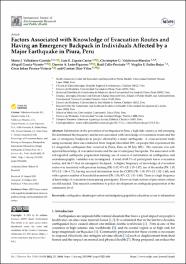Factors Associated with Knowledge of Evacuation Routes and Having an Emergency Backpack in Individuals Affected by a Major Earthquake in Piura, Peru

View/
Download
(application/pdf: 648.5Kb)
(application/pdf: 648.5Kb)
Date
2022-11-09Author(s)
Valladares-Garrido, Mario J.
Zapata-Castro, Luis E.
Valdiviezo-Morales, Christopher G.
García-Vicente, Abigaíl
León-Figueroa, Darwin A.
Calle-Preciado, Raúl
Failoc-Rojas, Virgilio E.
Pereira-Victorio, César Johan
Díaz-Vélez, Cristian
Metadata
Show full item recordAbstract
Information on the prevention of earthquakes in Peru, a high-risk country, is still emerging. We determined the frequency and factors associated with knowledge of evacuation routes and the use of emergency backpacks in people affected by a major earthquake. A cross-sectional study using secondary data was conducted from August–December 2021 on people that experienced the 6.1 magnitude earthquake that occurred in Piura, Peru on 30 July 2021. The outcome was self-reported knowledge of evacuation routes and the use of emergency backpacks. The association with self-reported earthquake preparation training, use of sources of information on earthquakes, and sociodemographic variables was investigated. A total of 69.5% of participants knew evacuation routes, and 46.3% had an emergency backpack. A higher frequency of knowledge of evacuation routes was associated with previous training (PR: 1.47; 95% CI: 1.15–1.87), use of the media (PR: 1.35; 95% CI: 1.06–1.72), having received information from the COEN (PR: 1.19; 95% CI: 1.02–1.40), and with a greater number of household members (PR: 1.03; 95% CI: 1.01–1.06). There is a high frequency of knowledge of evacuation routes among participants. However, basic notions of prevention culture are still needed. This research contributes to policy development on earthquake preparation at the community level.
Subject
Collections
- Web of Science (WOS) [236]

